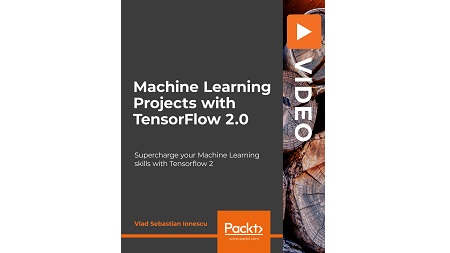
English | MP4 | AVC 1920×1080 | AAC 48KHz 2ch | 4h 20m | 965 MB
Build and train models for real-world machine learning projects using Tensorflow 2.0
TensorFlow is the world’s most widely adopted framework for Machine Learning and Deep Learning. TensorFlow 2.0 is a major milestone due to its inclusion of some major changes making TensorFlow easier to learn and use such as “Eager Execution”. It will support more platforms and languages, improved compatibility and remove deprecated APIs.
This course will guide you to upgrade your skills in Machine Learning by practically applying them by building real-world Machine Learning projects.
Each section should cover a specific project on a Machine Learning task and you will learn how to implement it into your system using TensorFlow 2. You will implement various Machine Learning techniques and algorithms using the TensorFlow 2 library. Each project will put your skills to test, help you understand and overcome the challenges you can face in a real-world scenario and provide some tips and tricks to help you become more efficient. Throughout the course, you will cover the new features of TensorFlow 2 such as Eager Execution. You will cover at least 3-4 projects. You will also cover some tasks such as Reinforcement Learning and Transfer Learning.
By the end of the course, you will be confident to build your own Machine Learning Systems with TensorFlow 2 and will be able to add this valuable skill to your CV.
Learn
- Strengthen your foundations to build TensorFlow 2.0 projects by exploring its new features
- Analyze the Titanic data set to obtain desired results with ease
- Implement and organize your Tensorflow projects in a professional manner
- Use Tensorboard to inspect various metrics and monitor your project’s performance
- Research and make the most of other people’s Kaggle solutions
- Use OpenAI Gym Environments for implementing state of the art reinforcement learning techniques using TF-Agents
- Apply the latest Transfer Learning techniques from Tensorflow
Table of Contents
Regression Task Airbnb Prices in New York
1 Course Overview
2 Setting Up TensorFlow 2.0
3 Getting Started with TensorFlow 2.0
4 Analyzing the Airbnb Dataset and Making a Plan
5 Implementing a Simple Linear Regression Algorithm
6 Implementing a Multi Layer Perceptron (Artificial Neural Network)
7 Improving the Network with Better Activation Functions and Dropout
8 Adding More Metrics to Gain a Better Understanding
9 Putting It All Together in a Professional Way
Classification Task Build Real World Apps – Who Will Win the Next UFC
10 Collecting Possible Kaggle Data
11 Analysis and Planning of the Dataset
12 Introduction to Google Colab and How It Benefits Us
13 Setting Up Training on Google Colab
14 Some Advanced Neural Network Approaches
15 Introducing a Deeper Network
16 Inspecting Metrics with TensorBoard
17 Inspecting the Existing Kaggle Solutions
Natural Language Processing Task – How to Generate Our Own Text
18 Introduction to Natural Language Processing
19 NLP and the Importance of Data Preprocessing
20 A Simple Text Classifier
21 Text Generation Methods
22 Text Generation with a Recurrent Neural Network
23 Refinements with Federated Learning
Reinforcement Learning Task – How to Become Best at Pacman
24 Introduction to Reinforcement Learning
25 OpenAI Gym Environments
26 The Pacman Gym Environment That We Are Going to Use
27 Reinforcement Learning Principles with TF-Agents
28 TF-Agents for Our Pacman Gym Environment
29 The Agents That We Are Going to Use
30 Selecting the Best Approaches and Real World Applications
Transfer Learning Task – How to Build a Powerful Image Classifier
31 Introduction to Transfer Learning in TensorFlow 2
32 Picking a Kaggle Dataset to Work On
33 Picking a Base Model Suitable for Transfer Learning with Our Dataset
34 Implementing our Transfer Learning approach
35 How Well Are We Doing and Can We Do Better
36 Conclusions and Future Work
Resolve the captcha to access the links!